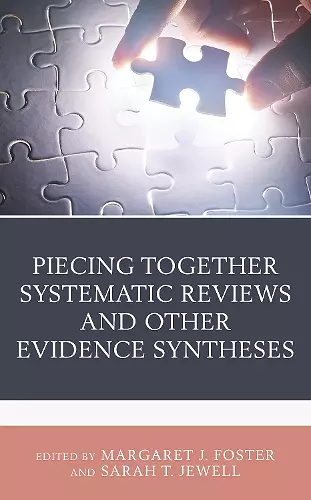Piecing Together Systematic Reviews and Other Evidence Syntheses
Margaret J Foster editor Sarah T Jewell editor
Format:Hardback
Publisher:Bloomsbury Publishing PLC
Published:2nd Nov '22
Currently unavailable, and unfortunately no date known when it will be back

Selected as a 2025 Doody’s Core Title
Systematic reviews and other evidence syntheses have a vital role in summarizing the literature, exploring gaps in research, prioritizing new research, and providing literature to support decision-making and evidence-based practices. Librarians adapt their practices as members of the higher education and research community. If they consult and teach with researchers, faculty, and students, review methods will likely be a part of their work.
Piecing Together Systematic Reviews and Other Evidence Syntheses: A Guide for Librarians aims to be the definitive text on systematic reviews for librarians, information professionals, and expert searchers. Starting with an introduction to evidence syntheses, the book follows the acronym PIECCESS, a framework for the 8 phases which flow through 8 processes. The 8 phases are (1) Proposal of scope; (2) Protocol registration; (3) Preliminary findings; (4) Paper completion; (5) Preserve project; (6) Promote to stakeholders; (7) Impact compilation; (8) Updating the review. The 8 processes are Plan, Identify, Evaluate, Collect, Combine, Explain, Summarize, and Share. After the processes of a review project are covered, guidance for developing and running a service is provided as well as teaching reviews and training for librarians.
The intended audience for this book is any librarian interested in consulting, collaborating, completing, or teaching reviews. It has several applications: for training librarians new to reviews, for those developing a new review service, for those wanting to establish policies for current service, and as a reference for those conducting reviews or running a service. Participating in reviews is a new frontier of librarianship, with expanded opportunities for new service, research areas, and professional activities. This book is part of the effort to standardize best practices when engaging in evidence syntheses.
The landscape of systematic reviews and evidence syntheses is one of both complexity and opportunity for librarians. Piecing together provides a comprehensive pathway through an oft uncertain space. oft uncertain space. It is not overstating to say that this thoroughly researched and resource-rich book is set to become a gold standard reference. * Journal of the Australian Library and Information Association *
Relying on a combination of cutting edge practices and tried-and-true techniques, Piecing Together Systematic Reviews and Other Evidence Syntheses provides a practical, up to date guide for librarians on all aspects of evidence synthesis, from planning to writing up results. -- Melissa L. Rethlefsen, MSLS, AHIP, Executive Director and Professor, Health Sciences Library and Informatics Center, University of New Mexico
Foster and Jewell’s team of authors demystify and delineate the expertise and effort involved in producing a high-quality systematic review or evidence synthesis. The framework and insights offered by this expert guide for information practitioners also make worthwhile reading for funders, reviewers, editors, and administrators supporting knowledge synthesis. -- Kristine Alpi, MLS, MPH, PhD, FMLA, Associate Dean of Libraries & Information Sciences, Icahn School of Medicine at Mount Sinai
While written primarily by librarians for librarians, the book could be of interest to anyone involved in evidence synthesis. Piecing Together Systematic Reviews and Other Evidence Syntheses is an accessible yet thorough overview of evidence synthesis as a process that requires many steps and collaborators. The book is a good starting point for librarians getting started with evidence synthesis. It is also a stimulating resource for librarians looking to extend their knowledge and skills. The book includes a chapter of four case studies, which document the process of planning different types of reviews. The chapter could be expanded into an entire book of its own, full of case studies of evidence synthesis collaboration. Significantly updated and expanded since its first edition, Piecing Together Systematic Reviews and Other Evidence Syntheses demonstrates not only how much librarians contribute to evidence synthesis projects but also how valuable it can be for librarians to write about the evidence synthesis process. * Medical Reference Services Quarterly *
Readers in multiple settings will find this book a beneficial and worthwhile investment. Librarians and administrators contemplating evidence review service development will find a user guide to librarian roles in project teams. Non-librarian researchers and students will be shown the depth and scope of systematic review projects. Although the content is geared to those with moderate exposure to evidence syntheses, the writing is clear and understandable for all levels of researcher and a valuable addition to medical, academic, and research library collections. * Technical Services Quarterly *
ISBN: 9781538150177
Dimensions: 237mm x 159mm x 27mm
Weight: 662g
366 pages